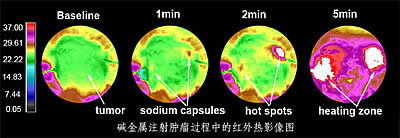
An infrared thermography image of tumor thermal ablation therapy using alkali metals
As an alternative to radiotherapy or chemotherapy for tumor treatment, which often cause serious side effects to patients, thermal ablation therapy has increasingly received attention. However, the traditional methods of thermal ablation that is based on such heating principles as ultrasound, radiofrequency, microwave and laser heating, are challenged by the difficulty of avoiding thermal damage to the healthy tissues along the path where heat is transferred from the outside to the target tumor inside the human body.
To address the problem, Prof. LIU Jing and his doctoral student RAO Wei with the CAS Technical Institute of Physics and Chemistry have invented a new approach for such a treatment by using alkali metals as the heat generation seeds. Experiments show that this method can efficiently ablate tumor tissues without causing thermal damage to the surrounding healthy tissues. Their work was reported online by the International Journal of Hyperthermia.
Alkali metals are famous for their vigorous reactions with water and usually considered as a hazard medium in daily life. The property is clearly used by CAS researchers to heal tumors. Its working principle is to make full employment of intrinsically existing wet environment in the biological body. After an injection or transplantation of only an extremely small amount of such metals into the target tissues, a significant temperature increase or even combustion at the target site can be obtained, which immediately results in a powerful thermal ablation effect on the tumor.
Because the metal will neither produce heat at the room temperature, nor keep contact with the tissue before an injection, unnecessary burning injury to the healthy tissues can be avoided. To make the metals easily transferred to targeted tissues via a common syringe, the researchers developed a new package preparation, which can keep the metal in liquid state at the temperature as low as -10˚C.
Experts say that since such treatment is safe, easy for both operation and post-care management, and rather economic, it allows a potentially wide adoption in the near future for the clinical treatment of tumors. In addition, the heating reaction's products such as ions of Na and K are the typical metabolites of the human body in its normal state, can be absorbed by the tissue itself without causing any damage.
However, the researchers note that the new therapy is still at its incubation and proof-of-concept stage. More efforts are needed on animal and clinical tests to justify the new therapy before it can be used in a real tumor treatment on humans in the near future. The present research is expected to serve as a valuable guidance for such an endeavor.





